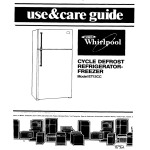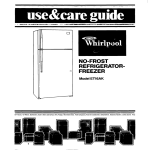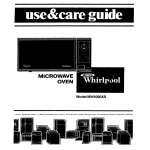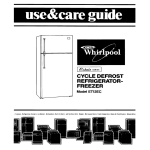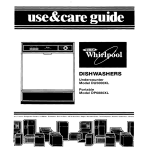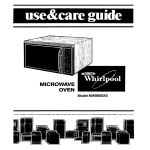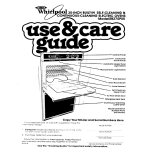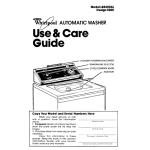Download Whirlpool ET17SCXL Specifications
Transcript
T&61 / 9 NO-FROST REFRIGERATOR-FREEZER Model ET17SCXL 01 Uk and Care Guide Juice Can Rack Ice Cube light Trays Shield Temoerature Conirol Compartment Base Grille Model and Serial Number Copy Your Model Number and Serial Number Here Wtien you need service, or call with a question, have this information ready: 1. Complete Model and Serial Numbers (from the plate just above base grille). 2. Purchase date from sales slip (or date installed], Copy this information in these spaces. Keep this book, your warranty and sales slip together in a handy place. Model Number I ~~~ Serial Number Purchase/Installation I Service Company Date and Telephone Number Please read this Use and Care Guide before you do anything This booklet tells you how clean it, move shelves and tells you what to do if you think something is wrong. Treat your new refrigerator do what home refrigerators else... to start your refrigerator, adjust controls. It even hear strange sounds or with care. Use it only to are designed to do. CONTENTS BEFORE YOU PLUG IT IN Install Properly Level Refrigerator-Freezer, Remove Sales Labels Clean It Plug It In., 2 3 3 3 3 3 USING YOUR REFRIGERATOR Setting the Controls Removing Shelves Removing the Crisper and Trivet Changing the Light Bulb Ice Cube Trays Removing the Base Grille Sounds You May Hear Energy Saving Tips 4 4 4 4 5 5 5 5 6 CLEANING YOUR REFRIGERATOR Cleaning Chart 6 7 FOOD STORAGE GUIDE Storing Fresh Food Storing Frozen Food 8 8 9 VACATION IF YOU I. 2. 3. 4. AND MOVING GUIDE 10 NEED SERVICE OR ASSISTANCE Before Calling for Assistance If You Need Assistance If You Need Service If You Have a Problem 10 10 11 11 11 Before you plug it in IMPORTANT Before using your refrigerator, you are personally responsible for making sure that it... l is installed and leveled on a floor that will hold the weight, and in an area suitable for its size and use. l is connected only to the right kind of outlet, with the right electric supply and grounding. l is used only for jobs expected of home refrigerators. l is not near an oven, radiator 01 other heat source. 2 l l l l l l is properly maintained. is out of the weather. is used in an area where the room temperature will not fall below 55” F (13” C). is not run where there are explosive fumes. is not used by children or others who may not understand how it should be used. is not loaded with food before it has time to get properly cold. Install Properly.. . Remove Sales labels... Remove the Consumer Buy Guide label and any inside sales labels before using the refrigerator. Remove any left over glue with rubbing alcohol. Allow 3 inches (7.5 cm) between overhead cabinets and the refrigerator top. Allow l/z inch (1.3 cm) between counters and sides of refrigerator. Allow at least 1 inch (2.5 cm) between the condenser and the wall. If the refrigerator is to be in a corner, keep 1% inches (3.1 cm) between the wall and the side of the refrigerator so there is room to open the doors wider. level Refrigerator-Freezer.. Clean your refrigerator before using it. See cleaning instructions on page 7. Plug It In... wall receptacle . A J-drong grounding plug t Refrigerator Power Cord Recommended Grounding Method I. 2. 3. 4. Remove base grille [see page 5). To raise front, turn each leg to the left. To lower front, turn each leg to the right. Check with level. A 120 Volt, 60 Hz., AC only, 15 ampere fused electrical supply is required. It is recommended that a separate circuit serving only this appliance be provided. Do not use an extension cord. Use a receptacle which cannot be turned off with a switch or pull chain. See individual electrical requirements and grounding instruction sheet in your literature package. 3 Using your refrigerator Temperathe Control Setting the Controls... Controls for adjusting temperatures are in the refrigerator. To start: I. Set the TEMPERATURE CONTROL to 3. 2. Set the AIR CONTROL to B. Give the refrigerator time to cool down completely before adding food. [This may take several hours). The control console has directions for adjusting temperatures, if needed. Controls will be set about right if your milk or juice is as cold as your family likes it, and when ice cream is firm. Do not block the air outlet on the control panel. That can slow the air movement needed to keep temperatures at the level you set. The POWER SAVING CONTROL on the control panel operates electric heaters. These [i@zz heaters help prevent moisture from forming on the outside of Ott Setting Helps the refrigerator when humidity is Save Energy high. l Use the OFF setting when humidity is low to save electricity. l Use ON only if moisture forms on the outside of the refrigerator, Air dontrol Removing - the Crisper and Trivet... Cover Supports Pull Forward I, Slide crisper straight out while lifting the front slightly. 2. Lift the front of the crisper cover from the shelf. 3. With both hands, pull the crisper cover forward until it clears the back supports. 4. Remove the shelf. Removing Shelves.. . l l l port Brackets Lift front slightly. Lift back off supports. Replace in reverse order. Lilt the Front Then the Back 5. Lift the trivet from the support back wall. 6. Replace in reverse order. brackets on the Removing the Base Grille... Changing the light Bulb... Before removrng the light shield for cleanrng replacing the bulb, unplug the refrigerator. oookmce bulbs on/v or for Use l Open the door rllle-holdlng labs Push in the Center; l l l l l Push lightly on the top center of the light shield untrl the notched tab unhooks from the control panel. Pull down on the shield until the tab clears the control panel. Lrft the back hooks out of their slots. Replace with a 40.watt appliance bulb. Replace light shreld In reverse order. Lift up on the two tabs showing at both ends near the top. l through the grille Ice Cube Trays... To remove Ice: l Hold tray at both ends. l Slightly twist. l l If cubes are not used, they may shrink. The moving cold air starts a slow evaporation. The longer cubes are stored, the smaller they get. l l Swing the top of the grille forward. Lift the grille off the bottom supports. Replace in reverse order. Do not remove Tech sheet fastened grille. behind the Sounds you may hear... Your new refrigerator may make sounds that your old one didn’t. Because the sounds are new to you, you might be concerned about them. Don’t be. Most of the new sounds are normal. Hard surfaces like the floor, walls and cabinets can make the sounds seem louder. The following chart describes the kinds of sounds that might be new to you, and what may be making them. Possible Sounds: Slight Hum, Soft Hiss: l l Clicking Sounds: or Snapping Probable Causes: You may hear fan motors and moving air. The defrost timer makes a definite click when the refrigerator also makes a sound when the refrigerator starts. stops running. It l Water Sounds: When the refrigerator stops running, you may hear gurgling in the tubing for a few minutes after it stops. You may also hear defrost water running into the defrost water pan. l Running Your refrigerator has a high-efficiency compressor and motor. It will run longer than older designs. It may even seem to run most of the time. Sounds: 5 Energy Saving Tips You can help your refrigerator use less electricity. l Check door gaskets for a tight seal. Level the cabinet to be sure of a good seal. l Clean the condenser coil regularly. l Open the door as few times as possible. Think about what you need before you open the door. Get everything out at one time. Keep foods organized so you won’t have to search for what you want. Close door as soon as food is removed. l Go ahead and fill up the refrigerator, but don’t overcrowd it so air movement is blocked. Cleaning your refrigerafor Both the refrigerator and freezer sections defrost automatically. But both should be cleaned about once a month to help prevent odors from building up. Of course, spills should be wiped up right away. To clean your refrigerator, unplug it, turn the Temperature Control to OFF, take out all removable parts, and clean it according to the following directions. 6 l l l It is a waste of electricity to set the refrigerator and freezer to temperatures colder than they need to be. If ice cream is firm in the freezer and drinks are as cold as your family likes them, that’s cold enough. Keep the Power Saving Control on OFF unless moisture forms on the refrigerator exterior. Make sure your refrigerator is not next to a heat source such as a range, water heater, furnace. radiator, or in direct sunlight. Part What to use Removable parts (shelves, crisper, etc.) Mild detergent warm water. How to clean and Wash removable parts with warm water and a mild detergent. Rinse and dry. l l Outside Sponge. cloth or paper towel; mild detergent. Wash with warm water and a mild detergent. Rinse and dry Do not use abrasive or harsh cleanserr. l l l Waxing is recommended in high humidity areas. Use a good auto paste wax or an appliance wax on painted metal surfaces. Do not use on plastic because it may damage these parts. Inside walls (Freezer should be allowed to warm up so cloth won’t stick.) Sponge, soft cloth or paper towel, baking soda, warm water, mild detergent. Door liners and gaskets Sponge, soft cloth or paper towel; mild detergent, warm water. Wash with warm water and - mild detergent or -baking soda (2 tablespoons 1 quart [ ,951 warm water). Rinse and dry l l DO NOT USE Cleaning bleaches or cleansers Defrost pan Condenser Coils Wash with mild detergent water. Rinse and dry l l waxes, concentrated contalnlng petroleum detergents, on plastic [26 gl to and warm parts. Warm water and mild detergent. Remove base grille [see page5). Remove defrost pan by sliding straight out. . Wash defrost pan with warm water and mild detergent. l Rinse and dry l Slide it back in all the way. Vacuum cleaner; use brush attachment. l l l l l l Clean dust and lint from condenser coils behind the refrigerator at least every other month. Slide refrigerator away from wall. Slide refrigerator back. Leave one inch (2.5 cm] between wall and condenser coil on back of the refrigerator. Food storage guide STORING FRESH FOOD Cured or Smoked Meat and Cold Cuts. Ham, bacon, sausage, cold cuts, etc., keep best in original wrappings. Once opened, tightly re-wrap in plastic wrap or aluminum foil. Canned Ham. Store in refrigerator unless the label says it’s okay to store on the shelf. Do not freeze. Fresh Poultry. Loosen the market wrapping and store in the supermarket tray, or loosely wrap in waxed paper or plastic wrap. STORAGECHARTFOR FRESHAND CUREDMEAT* Approxlmate Time rVr.(dwsl Variety Meats . . . . . . . . . 1 to 2 Chicken . . .. . .. . .... . . 1 to2 1 to 2 Ground Beef . . . . . . . . . . . . . Steaks and Roasts . . . . . . . . . . . . . 3 to 5 Cured Meats . . . . . . . . . . . . . . . 7 to 10 Bacon . . . . . . . . . . . . . . . . . . . . . . . . . . . . 5to7 Cold Cuts . . . . . . . . . . . . . . . . . . . . . 3 to 5 *If meat is to be stored longer than the times given, follow the directions for freezing. There is a right way to package and store refrigerated or frozen foods. To keep foods fresher, longer, take the time to study these recommended steps. Leaty Vegetables Remove the store wrapping and trim or tear off bruised and discolored areas. Wash in cool water and drain. Leave some water on the leaves as they go into the crisper. Cold, moist air helps keep leafy vegetables fresh and crisp. Vegetables wlth Skins (tomatoes, peppers) Wash, dry and store in a crisper. Fruits .Wash, dry and store in a crisper. Do not wash or hull berries until they are ready to use Sort and keep berries in their store container in a crisper, or store in a loosely closed paper bag on a refrigerator shelf. Meat* Meat is perishable and expensive...you won’t want to waste an ounce of it through careless handling. The following list and chart give you packaging hints and time limits. Fresh, Prepackaged Meat. Store fresh meat in the store wrapping. You can freeze it in the wrap and store it for one or two weeks. If you want to keep it frozen longer, you should wrap it with special freezer wrapping material. Fresh Meat, Not Prepackaged. Remove the market wrapping paper and re-wrap loosely in waxed paper 01 aluminum foil for storing it unfrozen. Cooked Meat. Wrap or cover cooked meat with waxed paper, plastic wrap or aluminum foil. Store immediately. I I NOTE: Fresh fish and shellfish should be used the same day as purchased. Eggs Store without washing in the original carton or use the egg nest in the door of your refrigerator. Milk, Beverages Wipe milk cartons and bottles. Store inside the refrigerator. Butter.. Stcre what you might use in a day in the Butter Compartment. When you have extra, wrap in freezer packaging and freeze. Cheese .Store in the original wrapping until you are ready to use it. Once opened, re-wrap tightly in plastic wrap or aluminum foil. Condlments .Store small jars and bottles (catsup, mustard, jelly, olives) on the door shelves where they are in easy reach. Lettovers .Always cover leftovers with plastic wrap or aluminum foil to keep food from drying out. Plastic containers with tight lids are fine, too. STORING FROZEN FOOD The freezer section is designed for storage of commercially frozen foods and for freezing foods at home. Remember to package and seal carefully. The only big secret to home freezing is airtight packages. Packages or containers should be sealed to keep natural moisture in and air out. Heavy-duty aluminum freezer foil, kraft paper with cellophane coating, special freezer bags, jars and cartons are all good. You can also get a special freezerpackage tape at most places that sell freezing and canning supplies. IMPORTANT: Do not expect your freezer to qulckfreeze any large quantlty of food. leave enough space for alr to circulate around packages. Be careful to leave enough room at the front so the door can close tightly. STORAGECHARTFOR FROZENFOOD Storage times given in this chart are only a guide. For best use of freezer space, keep frozen foods for short times. Use, then replace as needed. Bread .......................... 2 months Cooked Dishes ............... 2-3 months Fish and Seafoods Fresh ......................... 6months Commercially Frozen ...... l-3 months Fruits ........................... 6months Ice Cream ....................... 1 month Concentrated Juice .......... 4-6 months Meats Bacon ................ Less than 1 month Pork roasts, chops .......... 3-4 months Sausage .................... 1-2 months Beef, veal, lamb roasts ....... 6 months Ground meat ................ 1-2 months Poultry ..................... 3-4 months Vegetables .................... 6 months Ice Cream Store in the freezer. Once the package is opened, place a piece of aluminum foil or waxed paper smoothly against the surface. This will prevent ice crystals from forming. Packaged Frozen Food Store on freezer door shelf or in the freezer. If you plan to store it for a long time, re-wrap it with aluminum foil or plastic wrap. Frozen Me&* .The following hints will help keep the quality in your frozen meats: 1. Freeze meat while fresh and in top condition. 2. Use only the recommended wrapping materials. 3. Prepare the meat for freezing before wrapping it. Trim off excess fat and remove bones when practical. Meat should not be salted because salt shortens freezer life. 4. Wrap tightly, pressing out as much air as possible. 5. Label and date it. 6. Refreezing defrosted meat is not recommended. Frozen Soups, Juices .Store on freezer door shelf or in the freezer. *Courtesy of National Live Stock and Meat Board *Courtesy of U.S.D.A. Vacation and moving care If you need service or assistance, we su gest you follow these four !!i?eps: 1. Before calling for assistance... Performance problems often result from little things you can find and fix yourself without tools of any kind. If your refrigerator will not operate: Short Vacations. No need to shut off the refrigerator if you will be away for only a few weeks. Use up the perishables; freeze other items. Is the Temperature Control dial turned ON? If there is a rattling or jingling noise, or other unfamiliar sounds: l Is something on top or behind the refrigerator making noise when the refrigerator is running? l New features on your new refrigerator make new sounds. You may be hearing air flowing from the fans, timer clicks for the defrosting cycle, defrost water draining into the defrost pan. If there is water in the defrost pan: l long Vacations. Remove all the food if you are going for a month or more. Unplug the refrigerator and clean it...rinse well and dry Tape rubber or wood blocks to both doors ...keeping them open far enough for air to get in. This will keep odor and mold from building up. Tape the blocks out of a child’s reach...do not allow children near the retrlgerator when the doors are blocked open. To restart refrigerator, see “Using Your Refrigerator.” Moving. Remove all food. Pack frozen foods in dry ice. Unplug the refrigerator and clean it thoroughly. Remove everything that comes out. Wrap all parts well and tape them together so they don’t shift and rattle. Screw in the leveling legs; tape the doors shut; tape the electric cord to the cabinet. When you get to your new home, refer to the “Before you plug it in” section in this book. 10 In hot, muggy weather, this is normal The pan,, can , even be half full. Make sure the refrigerator IS level so the pan doesn’t overflow. If the light doesn’t work: l Check fuses and circuit breakers. Make sure it’s plugged in. l If a bulb is burned out: l See instructions for changing light bulbs on page 5. Use appliance bulbs only. If the motor seems to run too much: l Is the condenser, behind the base grille, free of dust and lint? l On hot days, or if the room is warm, the motor naturally runs longer. l If the door has been opened a lot, or if a large amount of food has been put in, the motor will run longer to cool down the interior. Remember: Motor running time depends on different things: number of door openings, amount of food stored, temperature of the room, setting of the controls. And, your new refrigerator may be larger than your old one so it has more space to be cooled. It also has a regular freezer instead of a frozen food compartment. All this means better refrigeration and may require more running time than your old one. 2. If you need assistance* ... Call Whlrlpool COOL-LINE’?~ service assistance telephone number. Dlal free from: Contlnental U.S. . . . . . . . . . . . . (800) 253-l 301 Mlchlgan . . . . . . . . . . . . . . . . . . . (800) 632-2243 . . . . . . . . . . . (800) 253-1121 Alaska 81Hawall and talk with one of our trained Consultants. The Consultant can instruct you in how to obtain satisfactory operation from your appliance or, if service is necessary, recommend a qualified service company in your area. 3. If you need service*... Whirlpool has a nationwide network of franchised TECH-CARE R to fulfill the product TECH-CARE service in your area, call our COOL-LINE service assistance telephone number [see Step 2) or look in your telephone directory Vellow Pages under: APPLIANCES-HOUSEHOLOMAJOR-SERVICE (L REPAIR ELECTRICALAPPLIANCESMAJOR-REPAIRING WHIRLPOOLAPPLIANCES FRANCHISEDTECHKARESERVICE WHIRLPOOLAPPLIANCES FRANCHISEDTECH-CARESERVICE SERVICE XYZSERVICECO 123 Maple COMPANIES OR SERVICE XYZSERVICECO 123 Maple 999-9999 8 PARTS COMPANIES 999-4999 OR WASHING MACHINES, 8 IRONERS-SERVICING DRYERS WHIRLPOOLAPPLIANCES FRANCHISEDTECH-CARESERVICE SERVlCE XYZSERVICECO 123 Maple C0MPA’ANIE.S 9'39-99'39 4. If you have a problem*... Call our COOL-LINE service assistance telephone number (see Step 2) and talk with one of our Consultants, or if you prefer, write to: Mr. Guy Turner, Vice President Whirlpool Corporation Administrative Center 2000 US-33 North Benton Harbor, Ml 49022 *If you must call or write, please provide: model number, serial number, date of purchase, and a complete description of the problem. This information is needed in order to better respond to your request for assistance. 11 FSP is a registered trademark of Whirlpool Corporation for quality parts. look for this FSP b symbol of quality whenever you need a replacement part ’ for your Whirlpool appliance FSP~replacemeni parts will fit right and work right, because they are made to the same exacting specifications used to build every new Whirlpool appliance 0 Benlon Harbor, Michigan. Automatic Washers, Clothes Dryers, Freezers, Retrigeralor-Freezers, Ice Makers, Dishwashers. Built-in Ovens and Surlace Units, Ranges, Microwave Ovens, Compactors, Room Air Conditioners, Dehumidifiers, Central Healing and Air Conditioning Systems. Part No. 942207 Printed in U.S.A












